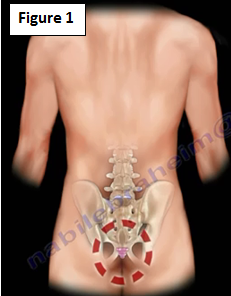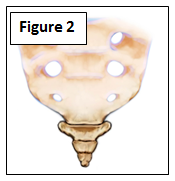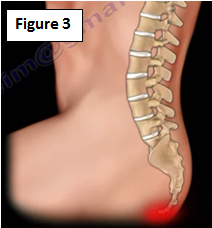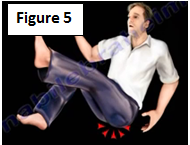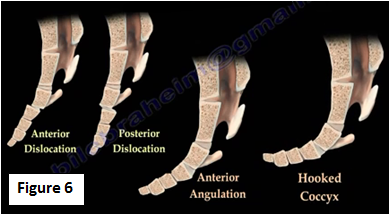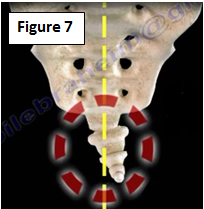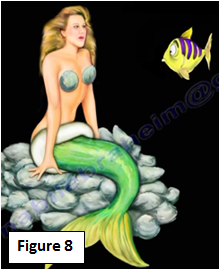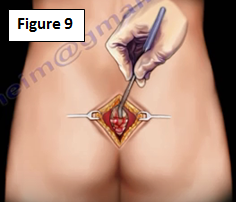Coccydynia refers to pain and tenderness originating from the coccyx. The coccyx is commonly referred to as the tailbone (Figure 1). It is a small curved V-shaped bone at the bottom of the spine (Figure 2). It is the final segment of the vertebral column comprising of two to four separate or fused vertebrae (lies below the sacrum).
The coccyx provides an important attachment for tendons, ligaments and muscles. Most doctors are not very familiar with the coccyx or its problems.
The coccyx has very little movement, excessive movement of the coccyx is abnormal. When sitting, the coccyx shifts forward and acts as a shock absorber (Figure 3). The coccyx bears more weight when the person is sitting and leaning backwards compared to when leaning forward.
Routine lumbosacral spine x-rays and MRI will not show the coccyx. If you want to view the coccyx, order coccyx views or MRI (Figure 4). Dynamic views of the coccyx, while the patient is sitting and leaning backwards is needed for imaging the coccyx. These x-rays should then be compared to films with patient standing or lying on their side. Imaging of the coccyx is always difficult and the x-rays, that are obtained, will be unclear. Some of the obstructing factors are bowels, obesity, and clothing artifacts.
Coccydynia Pain Symptoms:
Dull aching pain symptoms are associated with coccydynia. The pain becomes sharp during siting or when getting up from sitting, pain originating in the middle just above the anus, pain improves while leaning forward or to the side, and local tenderness over the area. Pain will increased during sex, defecation and menstruating.
The most frequent causes of coccyx pain are falling on the buttocks or backwards (Figure 5), fracture or dislocation due to trauma or injury, malignancy, infection, pregnancy or labor and idiopathic. Falling on the tailbone can lead to coccygeal pain, known as coccydynia, resulting in chronic inflammation of the sacrococcygeal joint. Dislocation of the coccyx occurs when there is a separation of the coccyx from the sacrum. Coccyx pain can also result from a tumor (chordoma), this needs to be ruled out.
Diagnosis:
To diagnose coccydynia, doctors will perform a thorough history and physical examination. During the examination, the doctor will inspect and palpate the area to identify pain/tenderness and any abnormal masses or abscesses. In addition, x-rays, CT scans or MRI's may be taken to confirm the diagnosis and to rule out other possible pathology.
Published types of coccyx injuries:
Types of coccyx injuries include anterior dislocation, posterior dislocation, anterior angulation, hooked coccyx (Figure 6). In addition to hooking and dislocation causing pain, there may be a side bend deformity causing the coccyx to be angled sharply. This side bend deformity is usually to the left (Figure 7).
Dural tension causing sacrococcygeal syndrome, low back pain and other symptoms is a non-proven theory. Curving of the coccyx causes an increase in dural tension. Coccygeal extension relieves tension and back pain.
Treatment:
Coccydynia can usually be treated conservatively. This treatment may include manipulation, therapy, cushion for sitting (doughnut, balloon, etc.) (Figure 8), injections, ultrasound, anti-inflammatory medications and surgery (as a last resort).
Surgical Treatment of Coccyx Injury:
A surgeon will begin by making an incision to expose the coccyx. Next, the muscles inserted into the coccyx have to be detached. The unstable part of the coccyx is then removed. The wound will then be irrigated and closed (Figure 9).
For more videos about the coccyx:
https://www.youtube.com/watch?v=L0CRM6r_Imo
For more videos, visit my YouTube channel:
https://www.youtube.com/user/nabilebraheim
